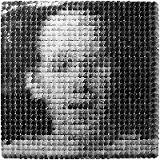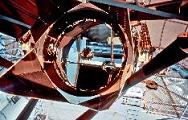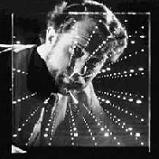Plasticine mirrors hide looking glass lies
Wednesday, January 11, 2006 → by Danieru The world is a reflection, cast by the remnants of light photons scattered onto the only point where your brain makes physical contact with the outside world: your eyes.
The world is a reflection, cast by the remnants of light photons scattered onto the only point where your brain makes physical contact with the outside world: your eyes.Yet with such abundance of reality mirroring humans still find the concept of reflection difficult to grasp:
'Participants [in a recent study] were... asked to estimate the image size of their head as it appears on the surface of the mirror. They estimated it would be about the size of their real head. But they based their answer on the image that appeared to be behind the mirror, not the image that really was on its surface.
People failed to see that the image on the surface of the mirror is half the size of the observer because a mirror is always halfway between the observer and the image that appears 'inside' the mirror.
Bertamini added: "Mirrors make us see virtual objects that exist in a virtual world; they are windows onto this world. On the one hand we trust what we see, but on the other hand this is a world that we know has no physical existence. This is one of the reasons why throughout history people have been fascinated by mirrors."' - link
 It is that 'inside the mirror' part that fascinates me. The retina of each of our eyes picks up an upside down, 2-dimensional reflection of the physical world around us which, when recombined by the brain, forms a superb 3-dimensional representation of our surroundings as mapped onto our visual cortex. Through the surface of the mirror and beyond into dimensions that do not exist the human perception can mould another 3-dimensional construct of reality inside the mirror. It appears that our brains' evolved 3d systems work equally well to project reality to the realm of the reflected image. The mirror is nature's way of showing us that reality is a mental construct.
It is that 'inside the mirror' part that fascinates me. The retina of each of our eyes picks up an upside down, 2-dimensional reflection of the physical world around us which, when recombined by the brain, forms a superb 3-dimensional representation of our surroundings as mapped onto our visual cortex. Through the surface of the mirror and beyond into dimensions that do not exist the human perception can mould another 3-dimensional construct of reality inside the mirror. It appears that our brains' evolved 3d systems work equally well to project reality to the realm of the reflected image. The mirror is nature's way of showing us that reality is a mental construct....Irrespective of whether we are awake or asleep, what each of us intuitively apprehends as the mind-independent world "out there" - colourful, noisy and hugely refractory - is a virtual simulation run by one's own mind/brain. "The World" as apprehended beyond one's body-image is simply one simulation among billions of throwaway genetic vehicles spawned by selfish DNA. Each autobiographical virtual world is identical with distinctive patterns of neuronal firings in a vertebrate CNS. Thanks to the playing out of millions of years of Darwinian natural selection, all but the most deranged mind/brains are coded to embody dynamic, data-driven simulations of their immediate environment. But such virtual worlds, like our conscious self, are no less fleeting, episodic and dispositional in their nature than are our beliefs and desires. In common with the conscious self, they disappear in a dreamless sleep.

The connection and activation weights of our neural nets, however, persist while their host organism slumbers. So "the world" abruptly recreates itself when we "awake". Opening one's eyes serves to re-impose selective discipline on our ways of worldmaking [in the proximate, non-Darwinian sense of "selective"]. Thus on waking up each morning, one's capacity to generate a virtual world becomes constrained once more by inputs from the optic nerve. This austere regimen contrasts with the psychotic excesses of one's dreams...
...In the course of evolution, natural selection has churned out billions of species-specific virtual worlds - rival organic quantum supercomputers - in creatures with central nervous systems. The simulations run by such virtual worlds serve as disposable genetic vehicles no less than the organisms who host them - and whom they help reproduce. Like their hosts, these virtual worlds senesesce and die.' - link
 In the organic realm many billions of years past before objective reality could be pondered, reordered and mentally-destroyed (by human consciousness). Can we ever use our evolved virtual expertise to transpose methods of reality resolution into the silicon/digital realm of our own creation? If our perception of mirrored realities is anything to go by we still have a long way to go to overcome our urge to place ourselves at the centre of an objective universe we know only through the perceptual, organic processes which so confuse us. Evolution saw it fit to offer us a fleeting reflection of truth. The mirror stands as the ultimate symbol of nature's cruelest joke.
In the organic realm many billions of years past before objective reality could be pondered, reordered and mentally-destroyed (by human consciousness). Can we ever use our evolved virtual expertise to transpose methods of reality resolution into the silicon/digital realm of our own creation? If our perception of mirrored realities is anything to go by we still have a long way to go to overcome our urge to place ourselves at the centre of an objective universe we know only through the perceptual, organic processes which so confuse us. Evolution saw it fit to offer us a fleeting reflection of truth. The mirror stands as the ultimate symbol of nature's cruelest joke.More mirrors: How vision works - The history of mirrors - Mirror neurons - The Tapetum Lucidium
Categories: Science, Weird, Brain, Consciousness, Human, Evolution, Nature, Reality, Future, News, Technology, Links
|
|

 Links
Links Subscribe via RSS!
Subscribe via RSS!


 Via Email
Via Email


Post a Comment